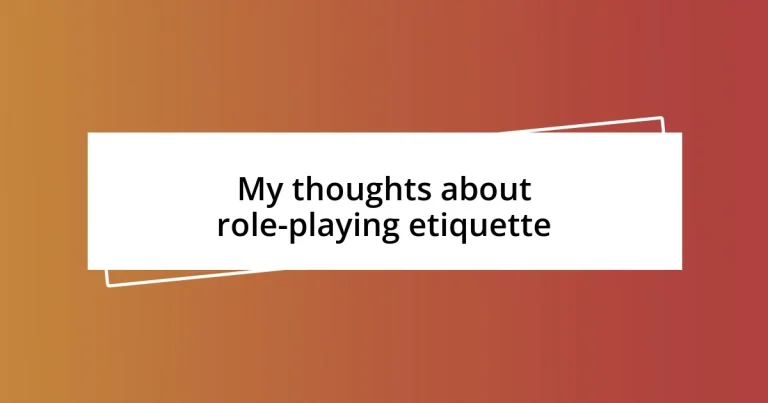Key takeaways:
- Understanding and respecting role-playing etiquette enhances group dynamics, fostering a supportive environment where everyone feels included.
- Effective communication techniques, such as regular check-ins and encouraging input, are essential for creating memorable stories and deepening player connections.
- Establishing boundaries and consent within the group promotes comfort, trust, and creativity, ensuring all players can engage freely in the narrative.
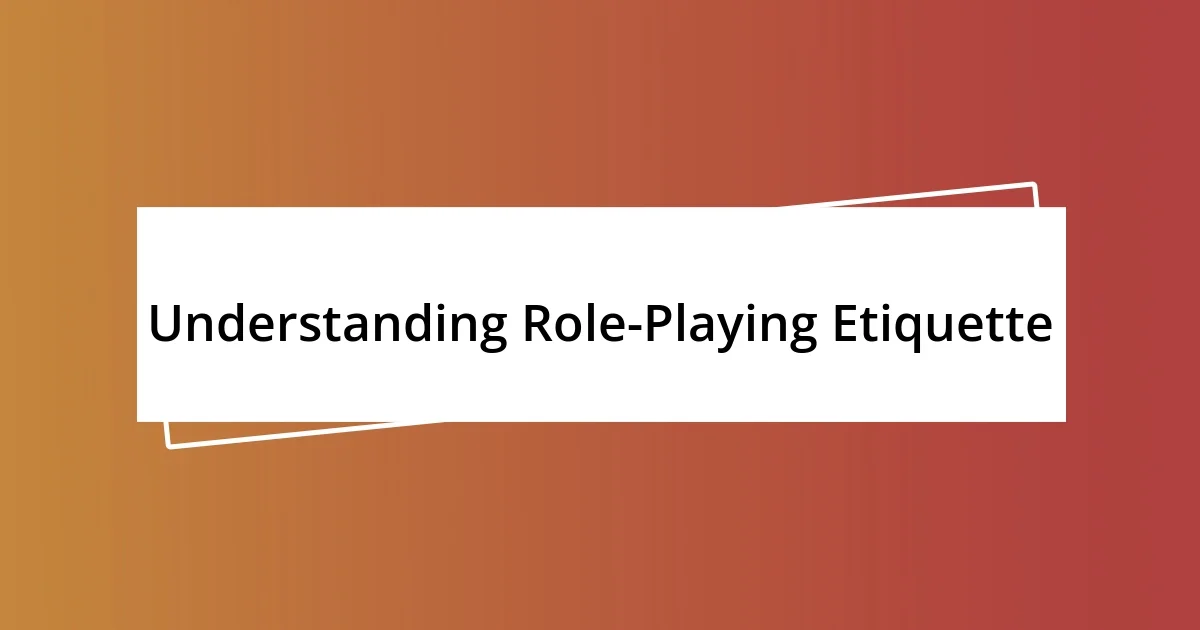
Understanding Role-Playing Etiquette
Understanding role-playing etiquette is crucial for creating a positive experience for everyone involved. I remember my first game; the buzz of excitement quickly turned to anxiety when I accidentally interrupted another player’s turn. This taught me the importance of patience and active listening in maintaining a harmonious atmosphere during sessions.
Moreover, being mindful of each player’s comfort zone is essential. I’ve witnessed a scene where one player was visibly uncomfortable with the direction the narrative took. It’s moments like these when the group dynamic can shift dramatically. How do we ensure everyone feels safe and included? I believe checking in with each other can make a huge difference, fostering a supportive environment where creativity can flourish.
Another key aspect is respecting the game master’s guidance. I learned this the hard way when I overstepped by suggesting dramatic changes to the story mid-session. Reflecting on that incident, I now understand how a game master’s vision sets the tone. It’s vital to collaborate, to enhance the story together rather than divert it from its original path. Isn’t it rewarding when everyone contributes to a shared narrative while respecting the framework established?
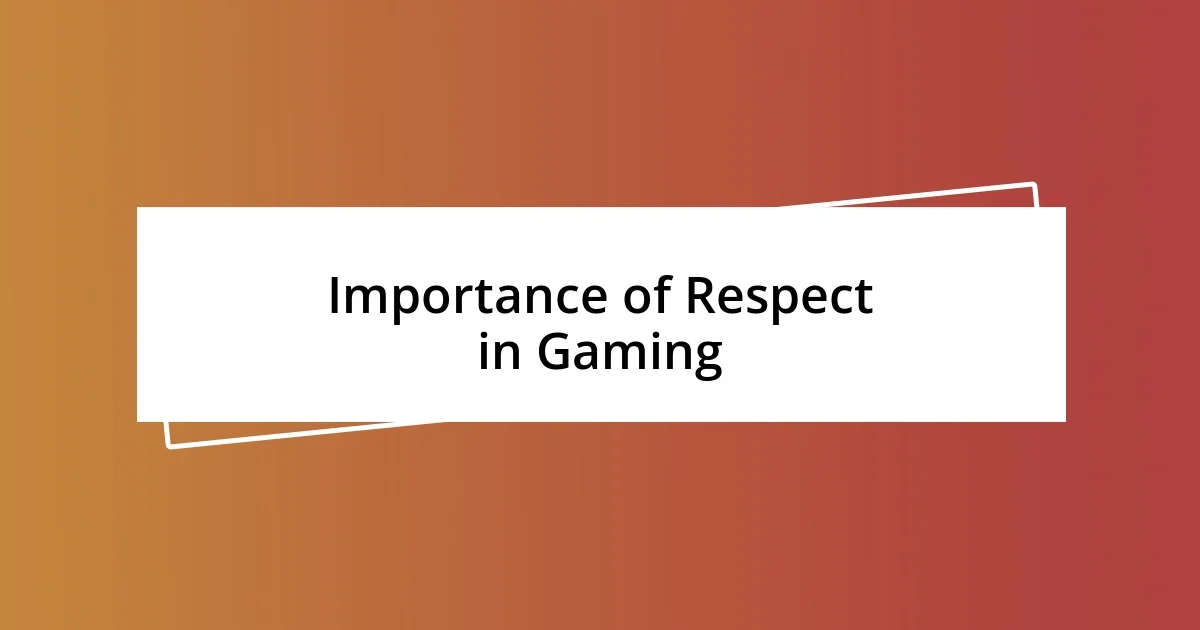
Importance of Respect in Gaming
Respect in gaming isn’t just a nice-to-have; it’s the backbone of an enjoyable session. I clearly remember a game night where one player constantly interrupted others. The tension in the room was palpable, and the joy of creativity diminished. In that moment, I recognized how crucial it is to maintain a respectful environment, where voices can be heard equally. After all, gaming should be about collaboration, not competition.
To truly embrace respect in gaming, consider these key aspects:
- Listen Actively: Give others your full attention. It’s amazing what you can learn just by tuning into what fellow players are saying.
- Honor Boundaries: Everyone has different comfort levels. I once saw a player disengage when topics became too dark, reminding me how vital it is to nurture everyone’s emotional safety.
- Be Patient: Allow each player their moment to shine. I find that when I wait my turn without rushing the process, it enhances the experience for everyone involved.
- Appreciate the Game Master: They’ve put in time and effort to craft the story. I’ve learned to respect their choices, and in return, the journey becomes richer and more enjoyable.
- Encourage Open Dialogue: A friendly chat about expectations beforehand can clear up misunderstandings and enhance trust among players.
Respect isn’t just a rule; it’s an essential melody that harmonizes our gaming experiences, allowing us to create memories that last well beyond the game table.

Communicating with Your Group
Communicating effectively within your group is vital for maintaining a positive role-playing experience. I remember one session when I noticed a player becoming increasingly quiet. Rather than brushing it off, I asked if they were comfortable with the current narrative direction. This simple act of checking in encouraged open communication, which led to a more collaborative atmosphere where everyone felt included.
In my experience, ensuring that everyone has the opportunity to voice their thoughts translates into a richer gameplay experience. For instance, during one campaign, I made it a habit to regularly prompt quieter players for their input. The result was astonishing; their unique perspectives introduced unexpected plot twists that breathed new life into our adventures. Isn’t that what we’re all here for—to create memorable stories together?
Lastly, establishing a group agreement on communication styles can prevent misunderstandings. I once participated in a game where we decided to use a safe word if any content became too intense. This agreement allowed us to enjoy the game freely while respecting each other’s boundaries. By fostering this type of transparency, you build trust and enhance the overall enjoyment of the gameplay.
| Effective Communication Techniques | Examples |
|---|---|
| Check In Regularly | Ask players if they’re comfortable with the storyline during key moments. |
| Encourage Input | Prompt quieter members for their thoughts, leading to unexpected plot twists. |
| Set Ground Rules | Use a safe word for intense moments to ensure emotional safety. |
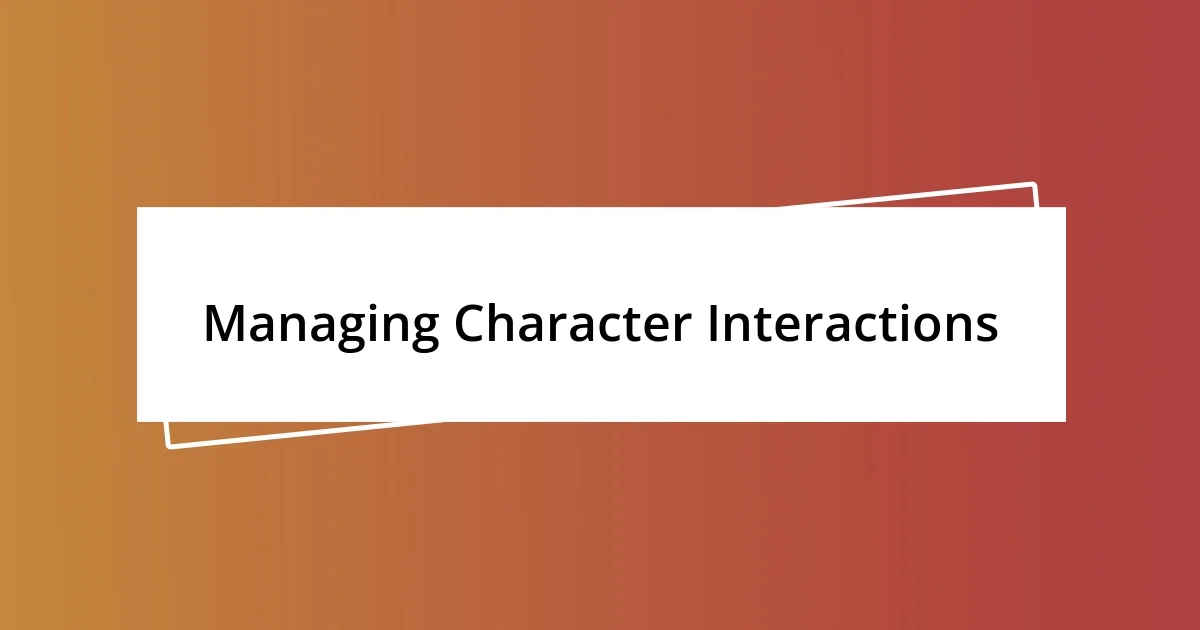
Managing Character Interactions
Managing character interactions can be a nuanced affair, often requiring a delicate balance of spontaneity and consideration for others. I remember a game where my character boldly challenged another. Instead of the fun back-and-forth I anticipated, it quickly dampened spirits—my tone didn’t convey the playfulness I intended. That moment taught me the importance of recognizing how my words can shape the group’s mood. Engaging in role-play means being aware not just of your own narrative but also how it intertwines with others’.
As characters collide, ensuring clarity in intentions becomes essential. Have you ever been in a game where a misunderstanding led to a heated debate rather than an engaging story? I certainly have. I’ve learned to articulate my character’s motives clearly, often pausing to read the reactions of others around the table. This approach fosters richer interactions and allows everyone to delve deeper into their roles. When we share an understanding of our characters’ goals, it invites collaboration rather than conflict.
Furthermore, it’s crucial to embrace the unexpected in character interactions. I recall a moment when a rival character unexpectedly offered my character an alliance. Initially taken aback, I embraced the twist. This spontaneity not only enriched our storyline but also brought everyone closer, as we navigated new dynamics together. Isn’t it fascinating how a single choice can alter the entire trajectory of a game? Flexibility in character interactions allows the narrative to blossom in ways we never anticipated.
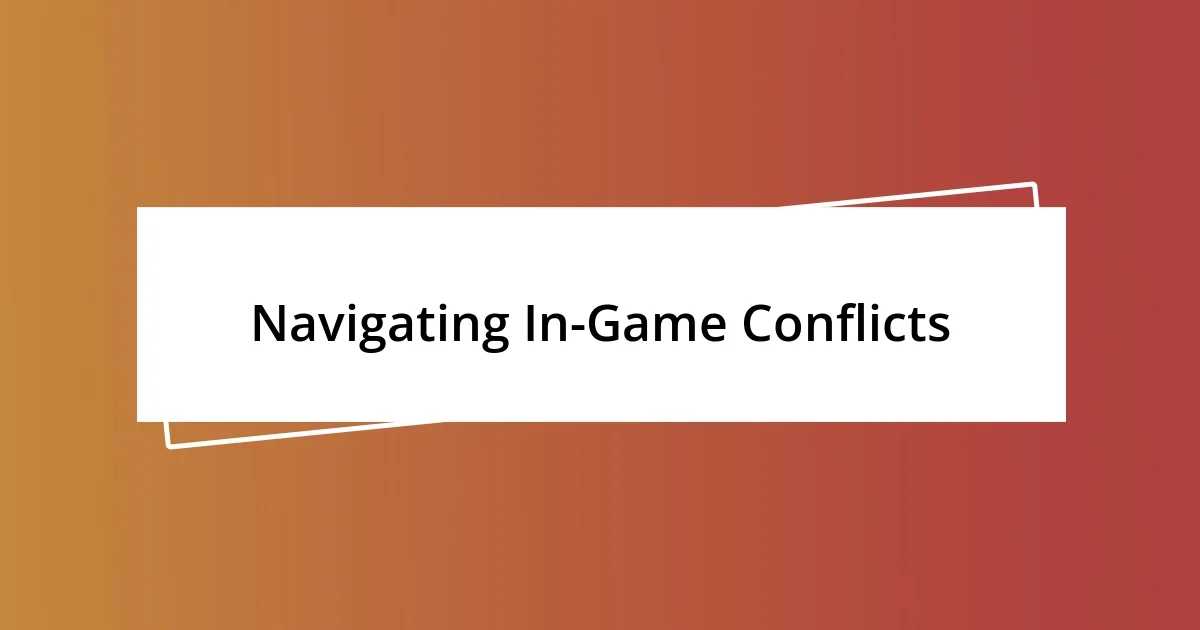
Navigating In-Game Conflicts
Navigating in-game conflicts requires a balance of assertiveness and empathy. I once faced a situation where my character unintentionally offended another player’s character during a mission. I could sense the tension rising at the table. Instead of ignoring it, I took a moment to apologize in character and reached out to the player afterward to discuss how we could move forward. That openness helped restore the collaborative spirit we all cherished.
It’s not uncommon for conflicts to stem from differing expectations. Have you ever found yourself at odds with a fellow player’s creative choices? I vividly remember a campaign where our conflicting visions nearly derailed a session. By addressing our differences head-on and discussing our goals for the scene, we transformed that friction into a dynamic scene that ultimately enriched the storyline. This experience reinforced for me the idea that discussing conflicts can often lead to deeper connections and more engaging narratives.
One key aspect I’ve learned is the importance of a cool-down period. After an intense in-game conflict, I suggested a short break to regroup and reflect. This offered everyone a chance to not only step back from their characters but also to engage in light-hearted conversations about the story we were crafting. Those moments of levity became essential for maintaining a positive atmosphere, reaffirming that, at the end of the day, we’re all in this together to create something special. How do you usually handle intense moments within your games?

Encouraging Inclusivity and Diversity
Creating an inclusive environment in role-playing games opens the door to richer stories and deeper connections among players. I recall a session where a new player joined us, feeling a bit shy about contributing. Instead of pushing her, we encouraged her to share her ideas. Hearing her unique perspective not only ignited creativity but also helped her feel more accepted. Have you noticed how the presence of diverse voices can elevate the narrative? It’s like adding vibrant colors to a canvas that may otherwise be too monochrome.
Diversity in character backgrounds and experiences also presents opportunities for collaboration. I once played in a campaign where characters hailed from vastly different cultures, which led to some enlightening discussions about their motivations and beliefs. One player’s character had a completely different view on trust based on their upbringing, which shaped how they interacted with others. This dynamic forced us to confront our biases—both in-game and out—making for a truly memorable journey. Isn’t it amazing how embracing differences can deepen our engagement in the story?
Furthermore, I’ve found that actively seeking input from all players fosters a sense of belonging. There was a memorable moment during a session when I asked everyone to share what they’d like to explore in our next adventure. The open dialogue resulted in a plot that integrated elements important to each player, from emotional arcs to personal stakes. By valuing each participant’s voice, I realized we built not just an engaging story, but also a stronger community. What steps do you take to ensure everyone feels included in your games? Reflecting on this can transform how we interact at the table.
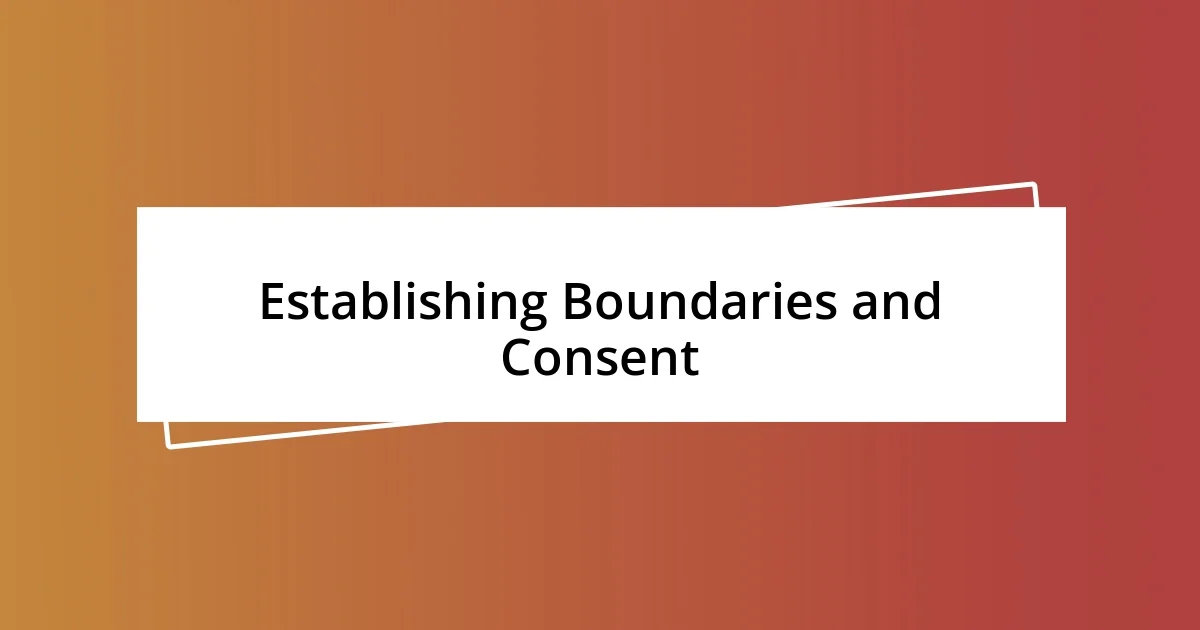
Establishing Boundaries and Consent
Establishing boundaries and consent is crucial in creating a comfortable atmosphere for all players. I remember a time when I embarked on a new campaign, and before diving in, we held a session zero. This initial meeting allowed us to openly discuss potential triggers and preferences, ensuring everyone felt safe to express their boundaries. Have you ever considered how a simple conversation could enhance trust among players?
It’s fascinating how setting boundaries can actually deepen connections. During one campaign, a fellow player shared that certain themes made her uncomfortable. By respecting her wishes and adjusting the storyline, we not only preserved her comfort but also cultivated a culture of respect within the group. It reminded me that boundaries aren’t limitations; they’re essential guidelines that allow for exploration and creativity without crossing personal lines. Doesn’t it feel good to know you can navigate the narrative together?
Consent, in my experience, goes beyond just discussing boundaries; it involves ongoing check-ins throughout the game. I once participated in a long-term campaign where we implemented a simple thumbs-up/thumbs-down system to gauge comfort levels during intense scenes. This quick feedback loop helped maintain a supportive environment. I found that regularly acknowledging each other’s feelings transformed our gaming sessions into safe spaces for vulnerability and genuine storytelling. How do you ensure that consent remains a priority in your games?












